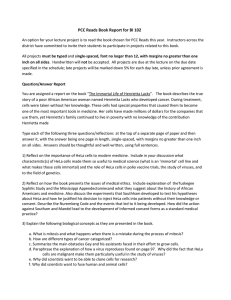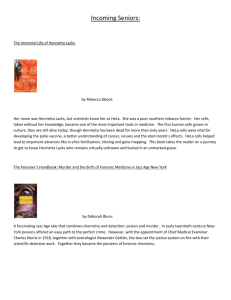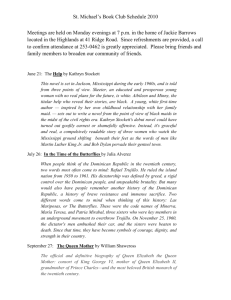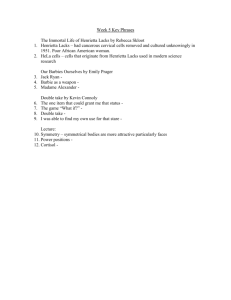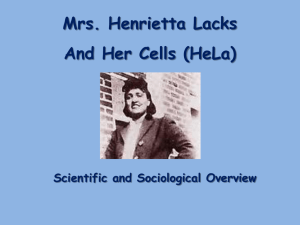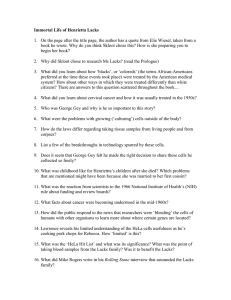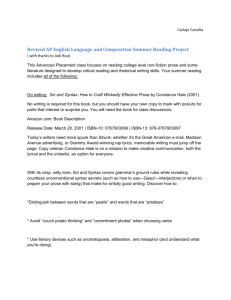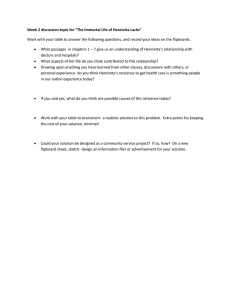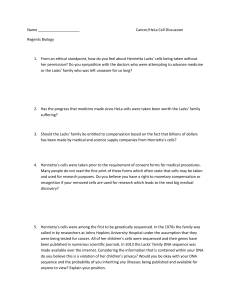BI 112 HeLa Homework Assignments:
advertisement
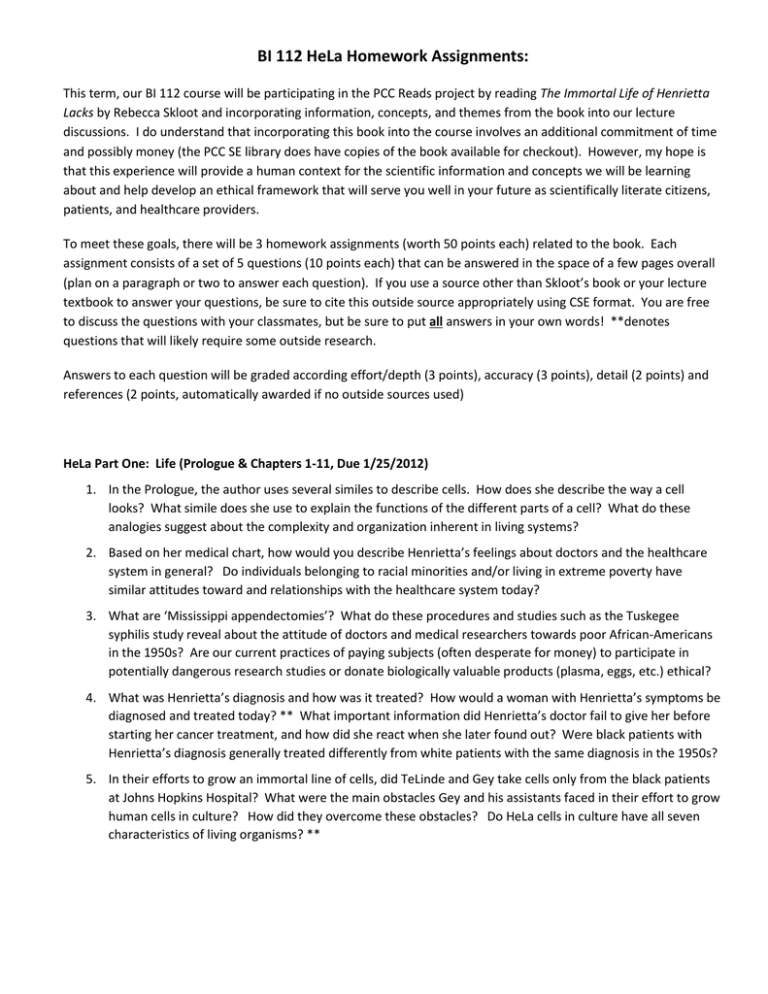
BI 112 HeLa Homework Assignments: This term, our BI 112 course will be participating in the PCC Reads project by reading The Immortal Life of Henrietta Lacks by Rebecca Skloot and incorporating information, concepts, and themes from the book into our lecture discussions. I do understand that incorporating this book into the course involves an additional commitment of time and possibly money (the PCC SE library does have copies of the book available for checkout). However, my hope is that this experience will provide a human context for the scientific information and concepts we will be learning about and help develop an ethical framework that will serve you well in your future as scientifically literate citizens, patients, and healthcare providers. To meet these goals, there will be 3 homework assignments (worth 50 points each) related to the book. Each assignment consists of a set of 5 questions (10 points each) that can be answered in the space of a few pages overall (plan on a paragraph or two to answer each question). If you use a source other than Skloot’s book or your lecture textbook to answer your questions, be sure to cite this outside source appropriately using CSE format. You are free to discuss the questions with your classmates, but be sure to put all answers in your own words! **denotes questions that will likely require some outside research. Answers to each question will be graded according effort/depth (3 points), accuracy (3 points), detail (2 points) and references (2 points, automatically awarded if no outside sources used) HeLa Part One: Life (Prologue & Chapters 1-11, Due 1/25/2012) 1. In the Prologue, the author uses several similes to describe cells. How does she describe the way a cell looks? What simile does she use to explain the functions of the different parts of a cell? What do these analogies suggest about the complexity and organization inherent in living systems? 2. Based on her medical chart, how would you describe Henrietta’s feelings about doctors and the healthcare system in general? Do individuals belonging to racial minorities and/or living in extreme poverty have similar attitudes toward and relationships with the healthcare system today? 3. What are ‘Mississippi appendectomies’? What do these procedures and studies such as the Tuskegee syphilis study reveal about the attitude of doctors and medical researchers towards poor African-Americans in the 1950s? Are our current practices of paying subjects (often desperate for money) to participate in potentially dangerous research studies or donate biologically valuable products (plasma, eggs, etc.) ethical? 4. What was Henrietta’s diagnosis and how was it treated? How would a woman with Henrietta’s symptoms be diagnosed and treated today? ** What important information did Henrietta’s doctor fail to give her before starting her cancer treatment, and how did she react when she later found out? Were black patients with Henrietta’s diagnosis generally treated differently from white patients with the same diagnosis in the 1950s? 5. In their efforts to grow an immortal line of cells, did TeLinde and Gey take cells only from the black patients at Johns Hopkins Hospital? What were the main obstacles Gey and his assistants faced in their effort to grow human cells in culture? How did they overcome these obstacles? Do HeLa cells in culture have all seven characteristics of living organisms? ** HeLa Part Two: Death (Chapters 12-22, Due 2/15/2012) 6. Why did Henrietta’s doctors need to ask for her family’s permission to remove tissue samples after her death? Why is this ironic? How did Day initially respond to their request? What made Day change his mind and allow the autopsy? 7. Paraphrase the explanation of how a virus reproduces found on page 97. Explain how a neutralization test is used to determine a vaccine’s efficacy. What two unusual characteristics of HeLa cells made them ideal for use in the polio vaccine trials? 8. ** How many chromosomes do normal human cells have? How did HeLa cells lead to this discovery? How many chromosomes do HeLa cells typically have? What are chromosomes made of? How large/long is a typical human chromosome? What persentage of the information on a human chromosome is used to build proteins? 9. What was Chester Southam concerned that HeLa cells might do? Describe the experiments that Southam conducted to test his hypothesis about HeLa and the results he found: Who were the test subjects in Southam’s first studies? Were they informed about the research and its risks? Based on these results, did his hypothesis appear to be correct? Where did Southam find test subjects for his second study? Were they better informed? How did Southam interpret the results of this experiment? Why, specifically, did the Jewish doctors at the Jewish Chronic Disease Hospital object to Southam’s study? 10. Who is Helen Lane? Do you agree with the decision to identify Henrietta Lacks in order to “give her the fame she so richly deserves,” or do you think her anonymity should have been protected? Would legal and institutional requirements of present-day scientific studies preserve the anonymity of a person who (willingly or not) donates cells or tissues that then go on to revolutionize biological research in the way that HeLa has for cell culture?** [some of the relevant laws are discussed in future chapters] Why or why not? HeLa Part 3: Immortality (Chapters 23-38 & Afterword. Due 3/14/2012) 11. Explain the difference between normal body cells and cancer cells. How do normal cells become cancerous? What, specifically, likely caused Henrietta’s cells to turn cancerous? How else can normal cells be transformed into cancerous ones? 12. What is the ‘Hayflick Limit’? What is the specific biological mechanism that this limit does not apply to HeLa cells? What is combined total weight and/or number of HeLa cells ever grown? How does this compare to the number of cells/weight of a typical person? 13. How long had Henrietta been dead when her family found out that ‘she’ was still alive? What were some of Deborah’s fears and concerns after she found out that her mother’s cells were still alive? Describe the ‘Aha!’ moment where Deborah fully understood what part of her mother had become immortal. 14. Why did researchers want DNA samples from Henrietta’s family in 1974? How well did Victor McKusick and Susan Hsu explain this need to the Lacks family before obtaining the blood? Did the family give informed consent for the research done on those samples? Was there a legal requirement to do so at that time? What does Susan Hsu’s request in the last paragraph of chapter 23 chapter reveal about her attitude towards the Lackses and how does this compare with Christoph Lengauer’s? 15. How has news media portrayal of scientific research (such as the immortal chicken heart of Alexis Carrel, the fusion of animal and human cells by Henry Harris and John Watkins to create hybrids, and recent efforts of researchers to clone cells and entire organisms) affected public perception of such research? What can we do to prevent baseless fears from undermining valuable scientific research, while at the same safeguarding against genuinely unethical uses of biotechnology?
